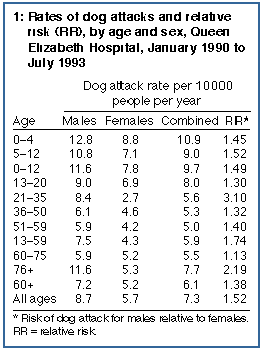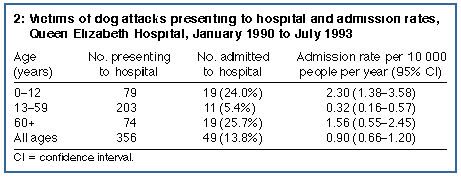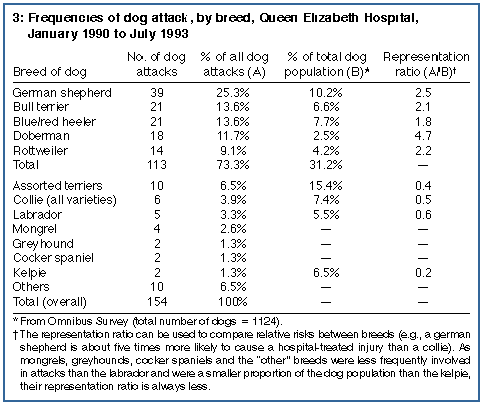The public health impact of dog attacks in a major Australian city
Peter G Thompson
Readers may print a single copy for personal use. No further reproduction or distribution of the articles should proceed without the permission of the publisher. For permission, contact the Australasian Medical Publishing Company
Journalists are welcome to write news stories based on what they read here, but should acknowledge their source as "an article published on the Internet by The Medical Journal of Australia <http://www.mja.com.au/>".
Abstract - Introduction - Methods - Results - Discussion - References - Authors' details
- ©MJA1997
Abstract |
Objective: To examine the impact of dog attacks by
determining the incidence and risk factors for dog attacks. Design: Injury surveillance data on dog attacks for a major metropolitan hospital were converted to incidence rates using 1991 census figures for the hospital catchment area and combined with data on community attitudes and experiences derived from a large community survey. Setting: Queen Elizabeth Hospital (tertiary referral hospital), Adelaide, South Australia, January 1990 to July 1993. Participants: 356 victims of dog attacks who presented to the emergency department and 3093 respondents to the 1992 South Australian Health Omnibus Survey. Main outcome measures: Rates of dog attack by age and sex of the victim, hospital presentation and admission; differences in the representation of various dog breeds in attacks. Results: About 6500 people are injured in Adelaide each year as a result of dog attacks and about 810 seek hospital treatment (7.3 per 10 000 people per year). Children aged 0-4 years were attacked and required hospital treatment twice as often as adults aged 21-59 years, and men aged over 76 years twice as often as men aged 36-75 years. Males were more at risk of attack than females for all age groups. Hospital admission rates were five times higher for the elderly (95% confidence interval [CI], 2.3%-10.2%) and seven times higher for children 12 years and under (95% CI, 3.4%-15.1%) compared with people aged 13-59 years; 90% of children were admitted because of head and facial bites. The risk of attack from german shepherds, bull terriers, blue/red heelers, dobermans and rottweilers was four to five times higher than for other common breeds. Conclusions: The public health implications of dog attacks are significant and there needs to be increased awareness of the risks to young children. Potential interventions to reduce the incidence of dog attacks vary from strict controls on high-risk breeds to mandatory leashing to a "user pays" liability insurance proposal. |
Introduction |
Dog attacks are a major cause of human injury in Australia. In 1991,
it was estimated that there could be up to 30 000 people
presenting to hospital annually as the result of dog attacks in
Australia.1 Injury records
from the Women's and Children's Hospital in South Australia show that dog attacks are the fourth most common reason for
children being taken to hospital, after accidents from playground
equipment, bicycles and motor vehicles.2 Studies from other States3,4 also report a high level of
childhood injuries related to dog attacks, and a recent South
Australian report5
confirmed that dogs were a significant cause of injury at all ages,
including the elderly. In the United States, there has been a 37%
increase since 1986 in dog bites that required medical attention, and
dog attacks eclipse measles, mumps and whooping cough combined as a
health threat to American children.6 To determine the impact of dog attacks and identify possible interventions to reduce their frequency, we examined surveillance data from a major metropolitan hospital in Adelaide and data from a large community survey. We report the rates of hospital treatment and admission for dog attacks, the severity of injuries, the groups most at risk of attack, community concern about dog attacks and a comparison of the relative risk between dog breeds. |
Methods | Two data sources were used in this study: the South Australian Health Commission's Injury Surveillance System, and the 1992 South Australian Health Omnibus Survey. In both data sources, a "dog attack" was defined as an intentional bite by the dog, or direct aggression causing injury to the victim. 1991 Census population statistics were also used to determine the age- and sex-specific rates of dog attack, as well as the age-specific rates of admission to hospital resulting from dog attacks. Ethics approval was provided by the University of Adelaide. |
Injury Surveillance System |
The South Australian Health Commission's Injury Surveillance
System automatically receives information from victims who present
to selected metropolitan public hospitals for treatment. For the
purposes of this study, it provided information about all
victims of dog attacks (e.g., age and sex of victim, type of injury,
location and description of incident and treatment) who presented to
Queen Elizabeth Hospital in Adelaide between January 1990 and July
1993. This system, which includes all age groups, has the advantage of
documenting the information at the time of treatment (in the
hospital), which reduces the possibility of subsequent recall bias.
Queen Elizabeth Hospital was chosen for this study because it has a well-defined catchment area with natural geographic boundaries on two sides. The other boundaries were determined by selecting the midpoint between adjacent public hospitals. Approximately 13% of the victims of dog attacks in the Adelaide metropolitan area who required hospital treatment between January 1990 and July 1993 presented to Queen Elizabeth Hospital. From a total of 356 attacks, the mean number by age and sex per year was calculated. The Injury Surveillance System provided the breed of dog (when it was known). We were confident that the breed names were accurate because in at least half of the attacks the victim was the dog's owner, a family member or a person who knew the dog well and the breeds named were common and easily recognised. Breeds that were unknown could have been a source of bias if their breed distribution was different. However, a comparison of victims who named the dog breed with those who did not failed to show any appreciable differences with regard to age, sex, dog ownership, body part injured and injury severity. The breed distribution of known breeds also largely agreed with other investigations.4,7-10 An indicator of the health impact of the injury on the person's life was whether the victim was admitted to hospital after initial examination in the emergency department. Those who were admitted were expressed as a proportion of the total number of people presenting to the emergency department. As data for all admissions came from the same hospital, the selection criteria for admission were likely to be consistent. The distribution of injury by body part was also examined. |
Health Omnibus Survey |
The 1992 South Australian Health Omnibus Survey11 contains information obtained
from interviews with 3093 randomly selected persons in Adelaide in
1992.11 The annual Omnibus
Survey is a population health survey that provides a large
representative sample of the attitudes towards health issues and
experiences of people aged over 15 years.
For our investigation, 13 questions concerning dog attacks were incorporated into the Omnibus Survey, including:
Respondents were also asked about injuries sustained and treatment received. Therefore, the Omnibus Survey provided data not only about victims of dog attacks who presented to hospital, but also data on victims of dog attacks who may have consulted a general practitioner as well as those who may not have been injured at all. The Omnibus Survey also provided information on the distribution of the dog population by breed. The frequency of breeds involved in attacks was converted to a representation ratio to compare the relative risks between breeds. The ratio was calculated by dividing the percentage of attacks per breed by the percentage of the total dog population represented by the same breed. Representation ratios allow confirmation of whether certain breeds of dog attack more frequently because they are more commonly chosen as pets (e.g., german shepherds may cause 25% of all attacks simply because they comprise 25% of the dog population). Population statistics from the Omnibus Survey as well as the 1991 Census were used to examine the demographics of the catchment area of Queen Elizabeth Hospital in comparison with metropolitan Adelaide. From an examination of the data on age, ethnicity and socioeconomic status, it was concluded that the catchment was representative of metropolitan Adelaide. |
Statistical analysis | Ninety-five per cent confidence intervals [CIs] for admission rates were attributed to Lilienfeld and Lilienfeld,12 and 95% CIs for admission rate relative risks attributed to Rothman's analysis of crude data.13 |
Results | |
Frequency of dog attacks: presentation to hospital |
Box 1 shows the age- and sex-specific rates of dog attack calculated
from victims who presented to the emergency department of Queen
Elizabeth Hospital from January 1990 to July 1993. The 356 dog attacks
for this period equate to 7.3 attacks per 10 000 people per year
requiring hospital treatment.
The rate of dog attack for men over the age of 76 was nearly double the rate for men aged 36 to 75, but this was not statistically significant, possibly because of the small sample size of older men. Notably, the rate for children aged 0 to 4 years was twice that for adults aged 21 to 59 years. This rate was likely to be conservative because some children in the catchment area of Queen Elizabeth Hospital may have been taken directly to the Adelaide Children's Hospital. There was also a marked difference between the rates for men and women. Men had, on average, a 50% higher risk of attack at all ages ( Figure 1). |
Frequency of dog attacks: community survey |
Of the 3093 respondents to the Omnibus Survey, one in 20 reported that
they had been attacked by a dog at least once in the past three years, and
a third had been attacked more than once in the past three years. More
than half (51%) reported that they had been attacked in a street or
public place.
Of the 88 people who reported in the Omnibus Survey that they had been injured by dogs and had required treatment, 35 people (40%) had consulted a doctor and 11 people (12.5%) had sought hospital treatment per year. The Omnibus Survey reported that 37.2% of households in metropolitan Adelaide owned at least one dog. The 1992 Dog Control Review Report estimated that there were about 190 000 dogs in metropolitan Adelaide.14 |
Admission to hospital | Box 2 (above) shows the number of victims of dog attacks who were admitted to Queen Elizabeth Hospital between January 1990 and July 1993. The rates of admission to hospital, as an indicator of the health impact of dog attack, were five times higher for elderly people (95% CI, 2.3-10.2) and seven times higher for children (95% CI, 3.4-15.1) than for people aged 13-59 years. Nearly two-thirds (66%) of children aged up to 12 years received head and facial bites ( Figure 2); these injuries were responsible for 90% of admissions in this age group ( Figure 3). |
Relative risk of dog attack, by breed |
Box 3 (below) shows the proportion of dog attacks by various breeds, the
representation of particular breeds in the total dog population, and
the relative risk of attack by those breeds (representation ratio).
The Injury Surveillance System provided the breed of dog in 43% of
attacks (154). It can be seen that the first five breeds were
responsible for 73% of all hospital-treated attacks, yet they
represented only 31% of the dog population.
The relative risk of attack by a german shepherd was about five times greater than a collie (2.5/0.5 = 5). Bull terriers, red/blue heelers and rottweilers presented a four-times-higher risk. The relative risk of attack by a doberman was even higher. It is possible that more dangerous dogs existed (e.g., the prohibited American pit bull terrier), but they did not feature in the Injury Surveillance System data because they comprised a small proportion of the dog population. |
Fear of dog attacks | Half of the respondents to the Omnibus Survey felt threatened or feared being attacked by dogs (95% CI, 48.4%- 51.9%). Of those who were afraid, 28.4% said their concern was minor in that it did not affect their behaviour, 18.7% felt moderate concern which had had an effect on their behaviour (such as planning safer routes away from known dogs), and the remaining 3.1% expressed major concern which had had more dire consequences (such as deciding not to leave the house to go shopping). |
Incidence of dog attacks |
The total number of attacks represented a rate of 2.85% per year, which
corresponds to about 29 000 attacks in metropolitan Adelaide each
year, based on the 1991 Census population of 1 023 278.
The total number of people injured and requiring treatment represented a rate of 0.63% per year, which corresponds to about 6500 people being injured and requiring treatment following dog attacks in Adelaide each year, with 2600 persons consulting a doctor and 810 seeking treatment at a hospital. If the overall rate of presentation to Queen Elizabeth Hospital following a dog attack (i.e., 7.3 per 10 000 people per year) is applied to the population of Adelaide, it corresponds to 750 persons presenting to hospital each year. This figure is close to the rate of 810 reported in the Omnibus Survey. If Adelaide is considered similar to most other Australian metropolitan areas, it could be expected that around 100 000 Australians will be injured and require treatment each year as a result of dog attack and that about 13 000 will seek treatment at a hospital. |
Discussion |
In this study, three-quarters of all hospital-treated dog attacks
were caused by just five of the 160 or so available breeds. Limiting the
availability of these breeds would be one way of reducing injury.
Alternatively, ownership could be restricted to certified owners
who accept responsibility to place specific controls on these
breeds. These controls include obedience training and dog
behaviour assessment, ensuring that the dog is on a leash at all times
in public, the home property is securely fenced and warning signs have
been erected for visitors. Owners should also be encouraged to join
dog clubs to raise awareness of the responsibilities involved in
owning a dog.
More than half the attacks reported in this study occurred in a street or public place by loose uncontrolled dogs. It is reasonable to assume that if the dogs had been restrained these attacks would not have occurred. The Australian Capital Territory, the Brisbane City Council, and a number of Victorian councils have adopted the strategy of requiring all dogs to be on a leash at all times in public. Councils in those States that still consider dogs need only be under the verbal control of their master in public places should consider this safer option. Brisbane City Council also requires mandatory fencing to contain dogs within their owner's property. Data from the Injury Surveillance System clearly show that dogs and very young children frequently do not mix.1 Parents of young children would be wise to postpone purchase of a dog until their children are older, preferably more than five years of age. A nationwide publicity campaign is recommended to alert parents to the dangers, especially in view of the high level of attacks to the head and face of children found in this study. Another option to reduce dog attacks could be to adopt a "user pays" element into dog ownership by introducing a third party insurance scheme. The issue of a registration permit could be conditional on the presentation of a suitable insurance agreement. In 1993, a South Australian court awarded $380 000 to a garbage collector for injuries sustained when attacked by an unrestrained dog -- the dog's owners were found responsible for the damages.15 For low-risk breeds, it is anticipated that there would be no additional premium to standard home insurance cover, but for high-risk breeds an increased premium would be likely. The premium would ultimately be determined by the extent of the claims relevant to each particular breed (i.e., the performance of the insured determines the cost). The paying of an additional premium would have the effect of deterring "spur-of-the-moment" buyers by encouraging them to think more carefully when choosing a breed and perhaps buy a lower-risk breed. Another benefit would result from insurance companies insisting on better ownership practices for particular breeds (as outlined at the beginning of the Discussion) before issuing policies. The rates of dog attack in Adelaide were projected to the nation as a whole because most Australians live in metropolitan areas and large regional centres (similar to Adelaide) and it was therefore considered that dog attacks were a widespread public health problem. The finding that half of the population surveyed were concerned about being attacked by dogs indicates that strengthening of dog-control policies will be more acceptable to the community than previously thought. In view of rising community concern and increasing media reports on dog attacks, owners must take more responsibility and put in place measures to reduce the incidence of dog attacks. |
References |
(Received 20 Aug 1996; accepted 26 May 1997) |
Authors' details
Injury Surveillance and Control Unit, South Australian Health Commission, Adelaide, SA.Peter G Thompson, MPH, Injury Epidemiologist.
Reprints will not be available from the author. Correspondence: Mr P G
Thompson, Public and Environmental Health Service, South
Australian Health Commission, PO Box 6, Rundle Mall, SA 5000.
E-mail: somers.ronald@health.sa.gov.au
©MJA 1997
<URL: http://www.mja.com.au/> © 1997 Medical Journal of Australia.
Received 11 January 2026, accepted 11 January 2026
- Peter G Thompson







